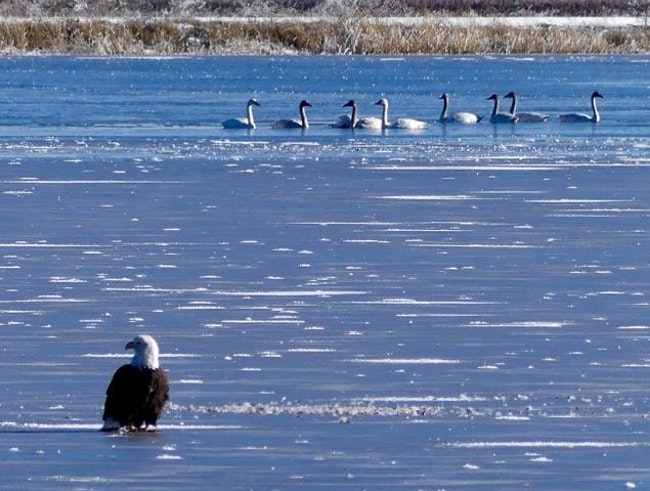 An eagle and tundra swans amid the ice in the Klamath Basin (Courtesy/Kirk Gooding)
An eagle and tundra swans amid the ice in the Klamath Basin (Courtesy/Kirk Gooding)
This season you might, from your home, your vehicle, even a sleeping bag, look outside and wonder: how can they survive? Birds are small, with higher body temperatures than ours, bare feet, bare beak, forced to eat outside. How can they stand the cold?
We know penguins, great gray and snowy owls, and ravens weather cold that sends most people indoors. Two champions of cold are geese. Andean geese live above 10,000 feet elevation. In Asia, Bar-headed geese migrate from Mongolia to India and back annually. Not a long flight, but it’s over the Himalayas.
These birds have been seen flying over 20,000 feet above sea level. There, it’s below freezing and the oxygen level is a fraction of what is at sea level. These birds are working hard, wings flapping. Research shows the geese have crucial biochemical adaptations so they do the near impossible.
Here in the Willamette Valley, many small birds huddle together at night, in roost cavities kindly provided by the local woodpeckers. Inside they share body heat—bushtits, nuthatches, downy woodpeckers.
The Anna’s hummingbird is marvelous is several ways—long beak and longer tongue, flying in any direction like a helicopter, iridescent feathers. But the Anna’s behavior in cold weather (below 40 degrees) may be its supreme accomplishment. The hummer goes into a cavity (thanks again to woodpeckers) and then turns down the thermostat.
In action, this bird has a body temperature of 100 degrees Fahrenheit or more. On a cold night it may drop fifty degrees. Its metabolism slows to survival level, energy use minimized. When it warms up outside, the bird cranks up the burners and gets back into action.
Feathers are fine insulation. Duck and goose down is the most efficient insulation known, natural or artificial. Birds spend at least 10% of their waking hours on feather maintenance. Birds’ lungs are more efficient than ours, delivering more oxygen than ours can. They have relatively larger hearts than ours, warm blood moving faster around the body. Birds eat and metabolize enormous amounts of food compared to mammals. They can lose a tenth of their body weight over a single night.
Cold feet? Some birds do get very cold feet: the surface temperature of their toes may be barely above freezing while the bird has a body temperature above 100 degrees. No frostbite because there’s little fluid in their feet which are mostly tendons and bones.
Birds also have a heat exchange process in their legs and feet. Blood vessels going to and from the feet are close together. Blood flowing back to the body is warmed by blood flowing to the feet. We may get cold feet looking out at snow. Not so the robin or mallard.
 Two great blue herons in the snow in the Klamath Basin (Courtesy/Kirk Gooding)
Two great blue herons in the snow in the Klamath Basin (Courtesy/Kirk Gooding)
For information about upcoming Salem Audubon programs and activities, see www.salemsudubon.org, or Salem Audubon’s Facebook page.
Harry Fuller is an Oregon birder and natural history author of “Freeway Birding.” He is a member of the Salem Audubon Society. Contact him at [email protected] or http://www.towhee.net/. His “Some Fascinating Things About Birds” column will be appearing regularly in Salem Reporter.
JUST THE FACTS, FOR SALEM – We report on your community with care and depth, fairness and accuracy. Get local news that matters to you. Subscribe to Salem Reporter starting at $5 a month. Click I want to subscribe!









